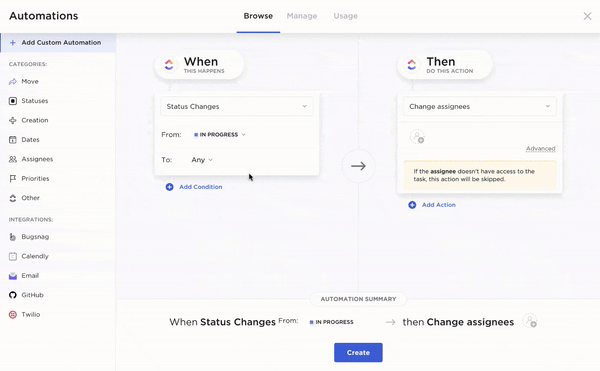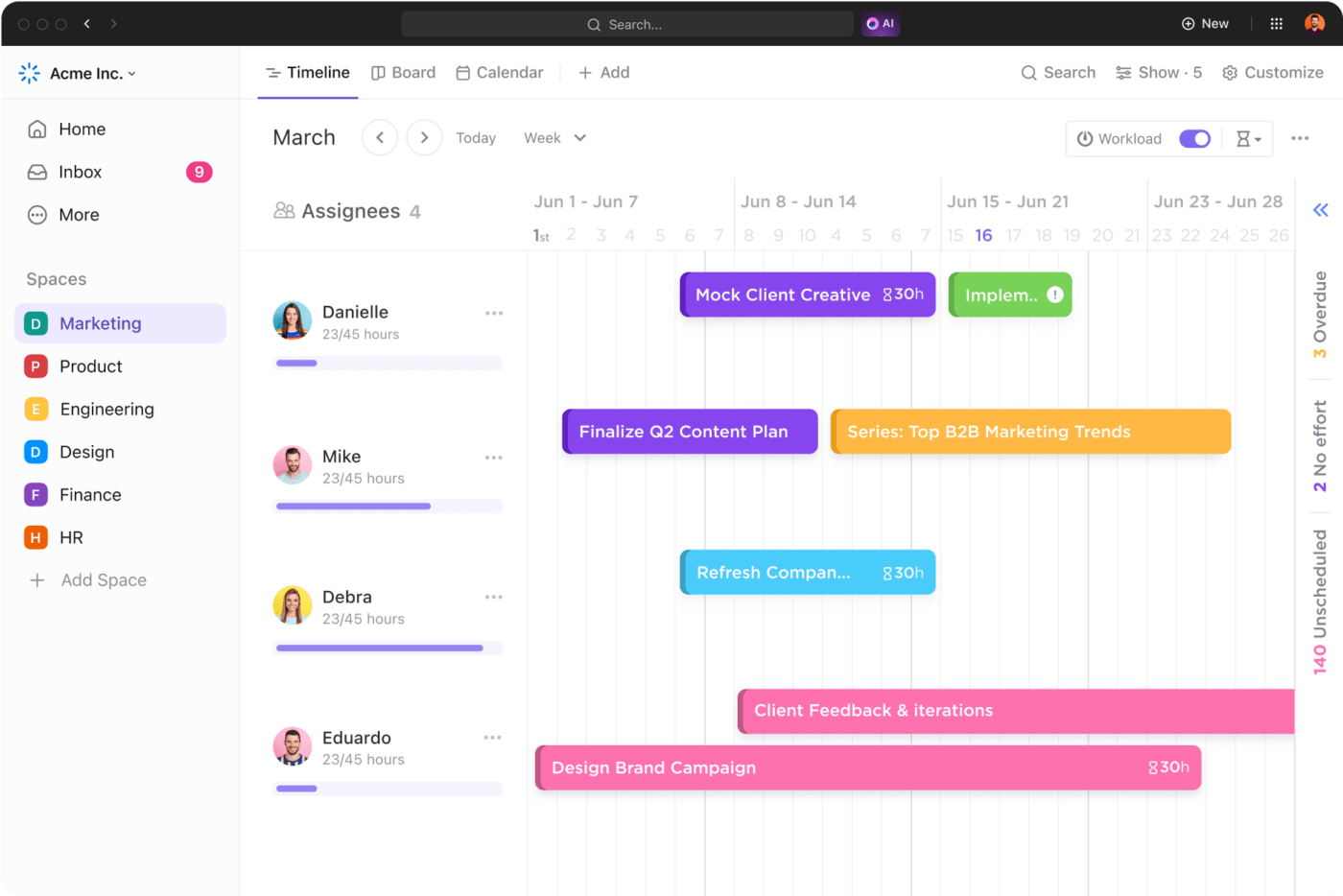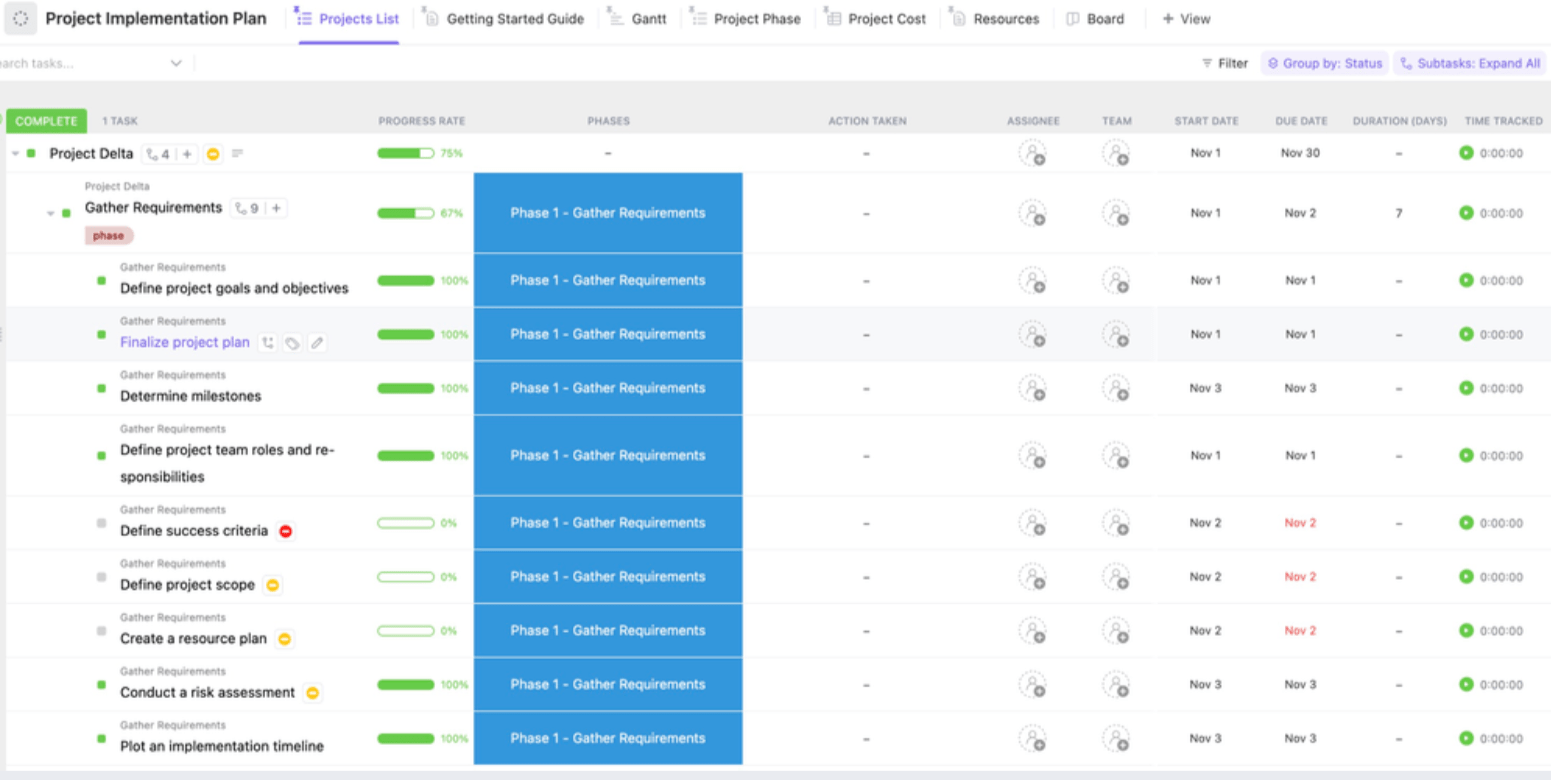

Projects come in myriad shapes and sizes, from your house remodeling to designing an enterprise data warehouse. Even within an organization, the engineering team might have a software development project, the HR a yearly team outing project, finance a budget allocation project, etc.
No matter the scale, every project has its own set of complexities. Effective project management is the only way to manage complexities, eliminate wastage, optimize resources, and reach the goal.
Thankfully, today, we have software that can take care of that. In this blog post, we explore how you can drive a successful project management software implementation in your organization—from planning to adoption.
- Understanding Project Management Software Implementation
- Understanding the Need for Project Management Software Implementation
- Key Steps for Implementing a Project Management Software
- Step 1: Conducting needs assessment and defining business requirements
- Step 2: Vendor selection and choosing the right software
- Step 3: Project launch and implementing ERP
- Step 4: Developing implementation timeline and setting objectives
- ClickUp implementation plan templates
- Step 5: Planning for training and support
- Step 6: Testing software configuration, acceptance testing, and quality assurance
- Overcoming Implementation Challenges and Risks
- Streamline Project Management with ClickUp
- FAQs About Project Management Software Implementation
Understanding Project Management Software Implementation
To understand what project management software implementation entails, you need to know the answer to several questions. Let’s get to it.
What is project management software?
Project management software is a digital tool designed to manage the activities, resources, and tasks related to a project. A good project manager would input all the data and events surrounding a project into the software and give all stakeholders visibility.

What is project management software implementation?
Project management software implementation is the process of selecting, setting up, and deploying project management tools for various users. We discuss the step-by-step process of this activity later in this blog post.
How did project management software implementation evolve?
Project management itself has evolved significantly over the last couple of decades.
Spreadsheet era: Early project management tools were simply spreadsheets. Project managers created endless tables and charts to manage all information in one place. This was highly manual and difficult to collaborate on.
ERP/CRM era: From spreadsheets, big organizations moved to enterprise resource planning (ERPs) and customer relationship management (CRM) software, which allowed them to manage tasks related to specific projects. For instance, CRM could handle the marketing workflow.
Without the focus on project management, these tools were a make-shift solution. They were inadequate and inefficient. Moreover, they were also a challenge to implement or even use.
Simple task manager era: As the SaaS model grew, many simple task management tools became popular. Project managers were fitting their hundreds of tasks into simple checklists, making managing projects at scale impossible.
Powerful project management software era: As the SaaS market matured, project management tools became significantly more powerful. An all-in-one project management tool like ClickUp empowers you to manage any kind of project precisely the way you want to.
With flexibility, customizations, integrations, and automation, powerful project management software is every project manager’s superpower!
It’s like having a virtual command center at your fingertips, enabling seamless communication, collaboration, and progress tracking.
Why is everyone talking about project management software now?
The pandemic and the rise in hybrid work models have placed project management software at the epicenter of organizational productivity. As a distributed workforce became the norm, project management software became the virtual office.
If that sounds like big talk, we hear you. Let’s see in granular detail why you need to consider project management software implementation.
Understanding the Need for Project Management Software Implementation
Your business is a bustling beehive of activity. Projects are the honey and your team, the diligent bees. Without a system to organize, prioritize, and track these projects, things can quickly become sticky. Good project execution can avoid that and add extraordinary value. Here’s how.
Consolidation: A project management software consolidates all the information, actions, and outcomes of a project. At any point, anything you—or anyone else—needs can be found here. This makes project management simple and effective.
Visibility: Implementing project management software provides visibility into all your projects, highlighting what’s on track and what needs a nudge. With this transparency, you can easily make tough decisions.
Collaboration: Among remote/hybrid teams, project management software implementation bridges the physical distance, enabling seamless collaboration regardless of time zones or locations.
Even if you are a co-located team, project management solutions enable collaboration with partners, vendors, customers, sponsors, etc., bringing every key stakeholder on the same page.
Predictability: Project management software lets you compare plans with actuals in real-time. You can tinker with your upcoming plans based on your performance to be more accurate.
Automation: Great project management software doesn’t just allow you to do the work but carries some of the weight, too. It automates repetitive/predictable processes, freeing up your project team’s time to focus on what they do best.

Continuous improvement: Project management software records everything about a project. Depending on where you look, it’s a treasure trove of insights into everything you can improve in the future.
As you can see, the benefits of project management software go far beyond just organizing work. It injects pace and precision into your business processes. It enables project managers to maximize outcomes from their existing resources.
However, the key to leveraging the best project management tools for business success is in the implementation. If you set it up wrong, it can become a nightmare, hindering work on a daily basis.
In the next section, we explore how you can set up your project management software to accelerate business success.
Key Steps for Implementing a Project Management Software
Implementing project management software sets the foundation for all activities you perform on it. Weak foundations can be unreliable and inefficient and, therefore, barely used.
To set a strong foundation, you need a successful software implementation plan. Well, you’re in luck! Here’s the roadmap with examples using a software development project.
Step 1: Conducting needs assessment and defining business requirements
Before you set out on your shopping trip, you need to figure out what you want. So, begin your project management software implementation with a comprehensive needs assessment process.
1. Gather requirements
Ask your project teams what they need. Identify every stakeholder involved in your organization’s projects and seek their input. For example:
- A developer might need features to add user stories, manage backlog, prioritize tasks, include acceptance criteria, etc.
- A quality analyst might need a description of use cases, checklists, the ability to comment to the developer, etc.
- The project manager might want to see reports, get notifications of overdue tasks, etc., like in a product management software
Make a clear list of everything you need in the project management software.

2. Identify challenges
Not all needs are articulated by team members. As Ford would say, when asked, most people think they need a faster horse. So, observe the current project management process and identify gaps.
For instance, if you’re managing projects on spreadsheets, you might sorely lack the ability to have a conversation around a specific task in context. This scattered communication makes work ineffective.
3. Define success
Clearly articulate what the success of project management software implementation would look like. Is it faster deployment cycles, enhanced team synergy, or better stakeholder satisfaction?
These metrics will come in handy while evaluating the return on investment in the project management software.
Step 2: Vendor selection and choosing the right software
The number of options you have for project management software is 442 (according to G2)! If you’re in charge of vendor selection, your work is cut out for you. Some of the most common features to look for while selecting the right product are as follows.
Task management
While this is the most basic need, ensure a hierarchy of checklists, sub-tasks, tasks, lists, folders, workspaces, etc. ClickUp’s project hierarchy is designed to enable better organization and greater control. For software teams, ClickUp also enables customizability for tasks, such as bugs, milestones, change requests, etc.
Documentation
All projects have resources, documents, and insights that the team members need to access from time to time. Choose a tool that enables this effortlessly.
ClickUp Whiteboard gives you a clean canvas to brainstorm/plan workflows. ClickUp Docs allows you to write and share documents at the click of a button. With ClickUp AI, you can automatically summarize long documents for easier access.

ClickUp’s project management templates also give you the springboard to get started!
Visibility
Not all projects make sense the same way. Project managers need different views to make different decisions.
ClickUp offers 15+ views to see your information your way:
- Calendar view helps in scheduling, dragging and dropping tasks for better efficiency
- Timeline view maps dependencies, so you can build contingency plans
- Workload view shows team availability and productivity for better resource allocation
- Chat view enables real-time collaboration

ClickUp includes agile project management tools for software teams, such as scrum boards, burnup/burndown charts, etc.
Integrations
A good project management tool must speak to your current and future tech stack. For a software team, this might be GitHub to link commits, pull requests, and issues.
For a content team, this could be connecting to Google Docs for easy access to all assets. And, of course, everyone likes Slack integration.
ClickUp seamlessly integrates with over 1,000 tools, including Vimeo, Zoom, and Tableau.
Once you’ve found a tool/project management software that checks all your boxes, it’s time to implement it and launch it for your users.
Step 3: Project launch and implementing ERP
This phase is pivotal, marking the transition from planning to action, where strategic vision starts taking tangible form.
- Get stakeholder sign-off: Bring the organizational leadership and sponsors on the same page about the vision and goals
- ERP set up: Configure the ERP system to ensure it is primed to support your implementation lifecycle and integrate other tools as appropriate
- Get a team onboard: Set up a project implementation team with project managers, supervisors, liaison officers, etc.
- Launch the project: Communicate with everyone involved, get the potential users excited about what’s coming
Step 4: Developing implementation timeline and setting objectives
When adopting a vendor’s software, it’s a project to manage the project management software implementation (yes, it’s a bit meta there!).
So, project management methodologies need to be followed:
- Breaking the project management software implementation into manageable tasks
- Planing a clear timeline for each task/milestone
- Setting clear objectives for the implementation, such as security standards, data transfer protocols, user onboarding, etc.
A project management software implementation plan is your roadmap, preempting every turn and checkpoint. If you’re new to implementation planning, we’ve got you covered.
ClickUp implementation plan templates
ClickUp’s Project Implementation Plan Template is your project’s blueprint to outline the project scope, phases, key activities, and responsibilities.
ClickUp’s Advanced Implementation Plan Template offers a comprehensive framework for software development projects that involve multiple teams or departments.
ClickUp’s Implementation Management Template is your project dashboard, offering a high-level view of progress, tasks, and milestones.
It’s similar to using a version control dashboard to monitor the development progress, branch statuses, and merge requests, ensuring the project progresses smoothly and stays aligned with its objectives.
Step 5: Planning for training and support
For organizations implementing new software, product adoption is one of the biggest challenges. If the tool needs to meet its vision and achieve its goals, everyone needs to embrace it and use it every day. This needs a little nudge.
- Create training programs to get users introduced to the product
- Identify early adopters who can become champions among their teams
- Collect feedback from early adopters and adjust accordingly
- Create project plan templates
- Set up mechanisms for ongoing support
Step 6: Testing software configuration, acceptance testing, and quality assurance
Before you close out the project management software implementation, there are three final steps.
Software configuration testing: Ensure that the project management software is implemented to your specifications. This includes:
- Any custom branding, colors, and logos
- User profiles and access control
- Authorization and authentication
User acceptance testing: Ensure that your users have tested all the features that they need. Encourage them to think of various scenarios in which they’ll use the product and test that workflow.
Quality assurance: This is a matter for your IT teams. Conduct thorough testing for security, vulnerabilities, integrations, compliance, etc. If you’ve used a software development template, you’ll have a checklist of everything to check at this stage.
However thoroughly you implement your project management software, you’re likely to encounter challenges. Let’s see how you can overcome them.
Overcoming Implementation Challenges and Risks
Adopting new software presents a number of technical, logistical, and cultural challenges. Here’s how you can avoid project management challenges or address them when they do arise.
Implement a change management strategy
Your organization is going to be resistant to change. This is normal and to be expected. To overcome this challenge, begin early.
While you’re implementing your new software, also execute a change management strategy.
- Communicate regularly and clearly with all stakeholders
- Schedule townhalls/meetings to eliminate fears and answer questions
- Discuss the transition to the new system
- Reassure your teams with plans to handle disruptions

Engage stakeholders early
No one likes new processes imposed on them from the top. So, engage them early and include them in the decision-making process.
Involve key stakeholders—such as project managers, team leaders, IT, and end-users—from the initial stages of selecting and planning software implementation. Understanding their needs, concerns, and expectations, ensuring the solution meets the requirements.
Start small and scale slow
If you change the entire project management system overnight, your teams are going to feel overwhelmed. To avoid this, phase it out.
Phased software implementation allows you to test the software with a smaller group, iron out concerns, and roll out company-wide when you’re absolutely sure.
Make training available
Today’s software is intuitive and doesn’t need comprehensive training to use. However, while discovering products by themselves, your users might miss out on powerful features they don’t encounter.
Make sure your project team uses the software to its full potential by offering training sessions. Make online tutorials, FAQs, and user documentation available. You can also do this informally by organizing knowledge-sharing sessions.
Monitor and optimize
Good software implementation process is ongoing. Monitor how users are using the product throughout the project management life cycle. Learn the most and least popular features. Collect feedback on what the product is missing.

Take all this back to the vendor and optimize the product regularly.
Streamline Project Management with ClickUp
Whether it’s a #lifeproject or a work-related project, managing it needs an armor of tools. ClickUp’s comprehensive project management software is designed to be your flexible, customizable, and powerful armor.
With features for creativity, collaboration, organization, conversations, reporting, and more, ClickUp’s free project management software empowers teams to work together effectively. ClickUp stands out as an all-encompassing tool that not only facilitates software implementation but also enriches distributed workforce management.
Whether you’re a software development team yourself or you’re a business incorporating a project management solution into your organization, ClickUp is made for you.
Don’t take our word for it. Try ClickUp for free today!
FAQs About Project Management Software Implementation
1. What is software implementation project management?
Software implementation project management is the structured process of planning, organizing, and overseeing the deployment of a software system in an organization.
This order of words—software implementation project management—refers to managing any software project.
It is slightly different from the topic of this blog post—project management software implementation—which refers to adopting a project management software.
2. How do you implement a new project management software?
Implementing a new project management software is a 6-step process consisting of:
- Conducting a needs assessment and defining business requirements
- Vendor selection and choosing the right software
- Project launch and implementing ERP
- Developing implementation timeline and setting objectives
- Planning for training and support
- Testing software configuration, acceptance testing, and quality assurance
3. What is system implementation in project management?
In project management, system implementation refers to the selection and adoption of a new software system. Often, organizations choose the term system implementation because they are also changing/optimizing their processes and workflows.




